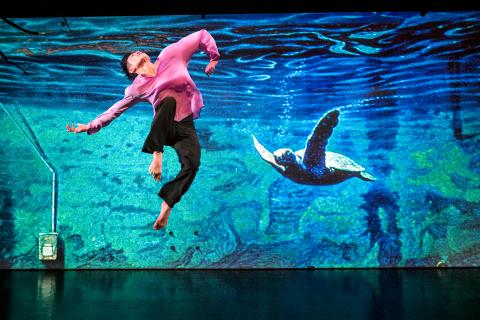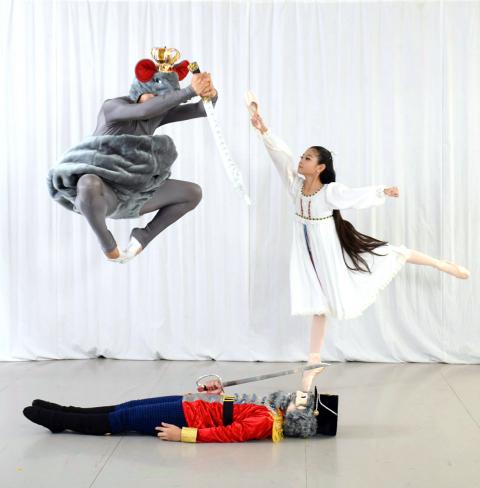Lin Hwai-min’s (林懷民) 2002 work Smoke does not quite live up to his promise of “a beautiful ballet.” It is a very strong piece — visually striking and is the most balletic of Lin’s creations — but the darkness, the feeling of loss that hang over it do not mesh with the word “beautiful.”
I missed seeing the show when it premiered at the National Theater in November 2002, which, having seen the piece on Friday last week, turns out to have been a significant omission in terms of following the progression of Lin’s works.
Coming between 2001’s Cursive (行草) and 2003’s Pine Smoke (松煙) — the first two works in Lin’s Cursive trilogy — Smoke, with women costumed by Sammy Wang (王世信) in brightly hued full-skirted dresses that flare out as they spin is both a sharp departure from the black/white/nude palette most of Lin’s works and a precursor of the kaleidoscope of colors worn in 2008’s Whisper of Flowers (花語) and 2011’s How Can I Live On Without You (如果沒有你).

Photo: Courtesy of Liu Chen-hsiang
Smoke begins with movements of life and promise, but turns progressively sharper and darker and becomes more emotional wrenching, a path Lin followed with greater depth in Whisper, just as the lifts and leaps that seemed such a departure in that work were actually used to great advantage in the earlier piece.
Smoke is also a reminder of the talent of Chang Tsan-tao (張贊桃), who was the company’s resident lighting designer until he died from lymphoma in 2010 at the age of 53. His circles of light pinpointing just the dancers’ hands in one segment in Act II — the fingers outstretched and twisted like the branches of the giant tree that dominates the stage — seem blazingly hot, yet the darkness that surrounds them is as black as ink. Chang was truly a master of light whose work gave an extra depth to so many of Cloud Gate’s classics.
Lin has said he does not plan to keep Smoke in the company’s repertoire. That is too bad, because is a reminder that his choreographic vocabulary extends far beyond the blend of modern dance/taichi/martial arts techniques that are most associated with him.

Photo Courtesy of the Kaohsiung City Ballet
The company will perform Smoke again on Nov. 13 and Nov. 14 at the Tainan Municipal Cultural Center.
SWEET NUTCRACKER
The Kaohsiung City Ballet’s (KCB, 高雄城市芭蕾舞團) production of The Nutcracker on Saturday night was as sweet as any of the sugary confections projected onto the cyclorama during Act II’s visit to the Land of Sweets.
Since the show was also designed as celebration of KCB founder and artistic director Chang Hsiu-ru’s (張秀如) 40th anniversary as a ballet teacher, it was a fitting blend of KCB members, old students-turned-colleagues and very young students — plus Ham Do-yuan, a South Korean imported to dance as the Sugar Plum Fairy’s cavalier after Chang’s original pick broke his ankle a few weeks ago.
Among the veteran dancers making an appearance were dancer/choreographer Wang Kuo-chuan (王國權), who played the role listed as “magician,” although Nutcracker devotees know him better as Drosselmeyer, Clara’s godfather who gives her the nutcracker that is at the heart of the ballet. Lu Chen-ying (盧蓁瑩) was the Sugar Plum Fairy, while Yeh Li-chuen (葉麗娟) performed the Spanish dance.
Chang and choreographer/videographer Constantin Georgescu streamlined the ballet to fit the abilities of the cast and to convey the story to audiences who might not be familiar with the Christmas tale. However, Georgescu added several nice touches — having Clara give Drosselmeyer her hair ribbon to bind up the Nutcracker after her brother breaks it, the smallest of the rat army crying as she sits next to the fallen Rat King as he is borne off stage, changing some of the Act II divertissements to solos or duets and adding a flock of sheep to accompany the shepherd and stewardess in the Dance of the Mirlitons or reed flutes.
Georgescu is also the magician who provided the vivid visual link between the sugary goodies that were once luxuries and the Act II dances they are supposed to represent — chocolate from the New World (the Spanish dance), coffee from the Middle East (the Arabian dance), tea (the Chinese dance), rock candies (the Russian dance) — filling the backdrop with projections of iced donuts, beautifully decorated cupcakes and cakes, candy canes, a technicolor Arabian mosaic, and fields of tea bushes and flowers. The pictures were stunning, but they never distracted from the action on the floor and more than made up for the lack of a set.
The show would make a wonderful annual or biennial production for the KCB, although the funding and logistics of dance productions in Taiwan probably make that an unlikely prospect. However, there is one more performance of The Nutcracker scheduled, for Saturday at the Pingtung County Art Center.

One of the biggest sore spots in Taiwan’s historical friendship with the US came in 1979 when US president Jimmy Carter broke off formal diplomatic relations with Taiwan’s Republic of China (ROC) government so that the US could establish relations with the People’s Republic of China (PRC). Taiwan’s derecognition came purely at China’s insistence, and the US took the deal. Retired American diplomat John Tkacik, who for almost decade surrounding that schism, from 1974 to 1982, worked in embassies in Taipei and Beijing and at the Taiwan Desk in Washington DC, recently argued in the Taipei Times that “President Carter’s derecognition

This year will go down in the history books. Taiwan faces enormous turmoil and uncertainty in the coming months. Which political parties are in a good position to handle big changes? All of the main parties are beset with challenges. Taking stock, this column examined the Taiwan People’s Party (TPP) (“Huang Kuo-chang’s choking the life out of the TPP,” May 28, page 12), the Democratic Progressive Party (DPP) (“Challenges amid choppy waters for the DPP,” June 14, page 12) and the Chinese Nationalist Party (KMT) (“KMT struggles to seize opportunities as ‘interesting times’ loom,” June 20, page 11). Times like these can

JUNE 30 to JULY 6 After being routed by the Japanese in the bloody battle of Baguashan (八卦山), Hsu Hsiang (徐驤) and a handful of surviving Hakka fighters sped toward Tainan. There, he would meet with Liu Yung-fu (劉永福), leader of the Black Flag Army who had assumed control of the resisting Republic of Formosa after its president and vice-president fled to China. Hsu, who had been fighting non-stop for over two months from Taoyuan to Changhua, was reportedly injured and exhausted. As the story goes, Liu advised that Hsu take shelter in China to recover and regroup, but Hsu steadfastly

You can tell a lot about a generation from the contents of their cool box: nowadays the barbecue ice bucket is likely to be filled with hard seltzers, non-alcoholic beers and fluorescent BuzzBallz — a particular favorite among Gen Z. Two decades ago, it was WKD, Bacardi Breezers and the odd Smirnoff Ice bobbing in a puddle of melted ice. And while nostalgia may have brought back some alcopops, the new wave of ready-to-drink (RTD) options look and taste noticeably different. It is not just the drinks that have changed, but drinking habits too, driven in part by more health-conscious consumers and